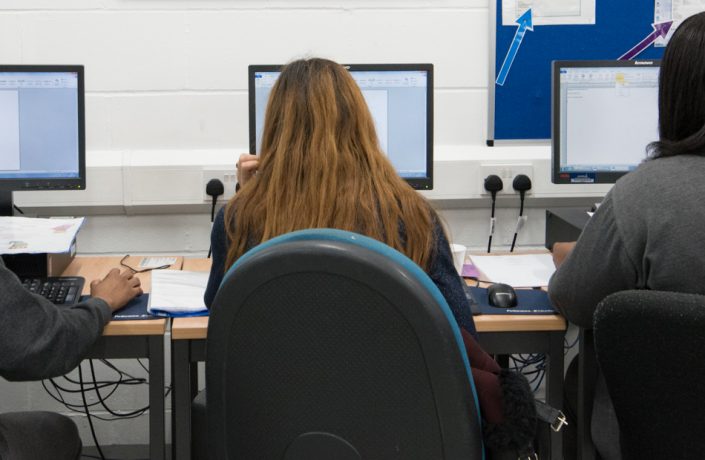 Click here to watch the Zoom recording
Click here to watch the Zoom recording
Dr Emma Palmer from the University of Leicester recently led an evaluation of digital technology in prisons as part of the Ministry of Justice’s Analytical Series. Ruth McFarlane, who chaired the webinar, is co-director of DWRM Consultants, a new social enterprise working with universities to increase the number of people in prison studying Further and Higher Education.
In this article, we have a look at some of the evaluation’s key findings.
View Emma’s slides here
The technology Emma set out to evaluate included in-cell PIN phones, self-service kiosks on wing landings, laptops in cells and P-Nomis on the Move (mobile devices for prison staff with access to Prison-National Offender Management Information System).
The evaluation was based on interviews and focus groups with prisoners and staff; surveys; analysis of management data on violence, prisoner self-harm and staff job satisfaction, and analysis of call data to the Samaritans; and task-time analysis.
The research set out to answer five questions. Does prison technology:
- Increase access to & improve communication of knowledge within
prisons?
- Improve prisoner confidence in using IT?
- Improve prisoner relationships with staff, other prisoners & those outside
of the prison?
- Increase staff job satisfaction & prisoner well being?
- Reduce prison officer time spent completing key activities/tasks?
Interactions and relationships
The evaluation found that all technologies had a positive impact on staff/prisoner relationships, and prisoner/prisoner relationships. The in-cell phones in particular reduced potential for conflict between prisoners, and between prisoners and staff.
There’s a positive side where you’re not having that confrontation there and then,
you’ve got a phone in your cell, there’s no reason that you need to be out on the
landing – Prison Officer
However, staff noted that bullying or conflict may have moved behind cell doors.
The technology also meant that prisoners could speak more regularly, privately and freely with family and friends, contributing to maintaining these relationships.
Now I’m able to sort of be a dad to my son and speak to him on that level….even if it’s
only a little two way phone call before bed just saying goodnight, I love you – Prisoner
Wellbeing
The technology also led to improvements in the psychological wellbeing of prisoners, particularly the in-cell phones. The technology was not found to have an effect on rates of prisoner self harm, although there was an increased number of calls and call minutes to the Samaritans after implementation.
I think it’s potentially gone as far as saving some prisoners’ lives…. in a cell you’re
able to have a lot more privacy – Prisoner
There was also an increased sense of autonomy and personal responsibility amongst prisoners, some of whom commented on a sense of pride around being able to manage some aspects of their lives.
Having their own laptop gives them responsibility, and it gives them a link to the
outside world – Prison officer
Staff didn’t think the technology affected the job satisfaction of wellbeing, and some commented that using P-NOMIS devices increased staff vulnerability on the wing.
Functionality and access
There were significant improvements from the previous arrangements, including better access to phones, and increased privacy and suitability of times for making phone calls.
The self-service kiosks and laptops improved the ability to submit and monitor applications, although responses were not always more prompt. Prisoners found that it was more straightforward to organise visits, and commented that kiosks and laptops had even more potential to provide information about events and to deliver other activities.
Yeah, you got a record. You can see the response. It’s much easier to keep digitally than it is to keep paper versions of everything – Prisoner
Some staff had reservations about P-NOMIS on the Move, including around connectivity issues and perceived limited functionality. Where it was used, it was seen to allow officers to do their jobs more effectively and efficiently, with more information to hand.
Uptake and use of technology
The uptake of digital technology was good. Misuse of technology was rare, though prisoners’ self-reported confidence or skills using IT was not affected.
There’s people who have been ‘I’m never going to be able to use that, I’m too old or
I’ve not used a computer’, but the guys are quite helpful with each other – Prison Officer
Some prisoners were unfamiliar and reluctant to engage with technology in general, and some were concerned about taking responsibility for hardware given the financial penalties.
Impact on staff workload
Self-service kiosks and laptops reduced workloads and time taken to complete certain activities for wing-based staff. The research also found that:
In those prisons that do not currently have kiosks/in cell laptops, the future implementation of these technologies may have the potential to reduce the time it takes to complete certain activities/tasks
The Prisoner Learning Alliance would like to see the use of in-cell technology across the prison estate to support the re-introduction of face-to-face education and to facilitate a blended learning approach.
Find out more about the PLA’s work on digital technology
08 Jul 2020 | Prisoner Learning Alliance | PDF | 1.83MB
The Digital Divide: Lessons from prisons abroad
Our briefing looks at the use of digital technology in prisons from Spain to Australia, of in-cell tablets to virtual reality headsets. We hope that England and Wales can learn from some of these lessons from abroad.

